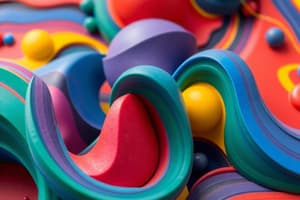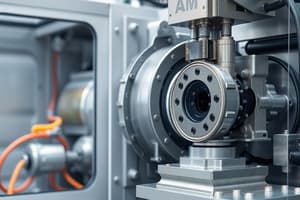Podcast
Questions and Answers
What is the first key step in the Additive Manufacturing process chain?
What is the first key step in the Additive Manufacturing process chain?
- Part removal and cleanup
- Machine setup
- Post-processing of part
- Conceptualization and CAD (correct)
STL stands for Standard Triangle Language.
STL stands for Standard Triangle Language.
False (B)
Name one application area of Additive Manufacturing that does not involve conventional CAD modeling.
Name one application area of Additive Manufacturing that does not involve conventional CAD modeling.
Medical modeling
The Additive Manufacturing process involves _____ and CAD, which is the initial step.
The Additive Manufacturing process involves _____ and CAD, which is the initial step.
Match the following types of Additive Manufacturing systems with their characteristics:
Match the following types of Additive Manufacturing systems with their characteristics:
Which of the following is NOT a factor to consider during the design for Additive Manufacturing?
Which of the following is NOT a factor to consider during the design for Additive Manufacturing?
Energy density is an important consideration for metal Additive Manufacturing systems.
Energy density is an important consideration for metal Additive Manufacturing systems.
What does CAD stand for in the context of Additive Manufacturing?
What does CAD stand for in the context of Additive Manufacturing?
What is often required when removing support structures from 3D printed parts?
What is often required when removing support structures from 3D printed parts?
Post-processing stages in additive manufacturing often involve automated processes.
Post-processing stages in additive manufacturing often involve automated processes.
What is a potential drawback of parts produced through additive manufacturing?
What is a potential drawback of parts produced through additive manufacturing?
During post-processing, abrasive finishing techniques like _____ and _____ may be utilized.
During post-processing, abrasive finishing techniques like _____ and _____ may be utilized.
Match the following processes with their descriptions:
Match the following processes with their descriptions:
What might happen to parts created by additive manufacturing when subjected to mechanical stress?
What might happen to parts created by additive manufacturing when subjected to mechanical stress?
All additive manufacturing applications require high-performance components.
All additive manufacturing applications require high-performance components.
What is a critical step before building the part?
What is a critical step before building the part?
What does anisotropic mean in the context of additive manufacturing parts?
What does anisotropic mean in the context of additive manufacturing parts?
What type of technology is primarily used for reverse engineering data?
What type of technology is primarily used for reverse engineering data?
Only one part can be built at a time using AM machines.
Only one part can be built at a time using AM machines.
What must be done to ensure final part quality in AM processes?
What must be done to ensure final part quality in AM processes?
Architectural modeling strictly adheres to exact final designs without any modifications.
Architectural modeling strictly adheres to exact final designs without any modifications.
What software is designed to convert World of Warcraft models into a specific format?
What software is designed to convert World of Warcraft models into a specific format?
With AM machines, the process switches to __________ after the first few semi-automated stages.
With AM machines, the process switches to __________ after the first few semi-automated stages.
Match the following AM machine setup characteristics with their descriptions:
Match the following AM machine setup characteristics with their descriptions:
Processes combining additive and ___ elements represent a trend in modern manufacturing.
Processes combining additive and ___ elements represent a trend in modern manufacturing.
What is a common practice during the Removal and Cleanup phase?
What is a common practice during the Removal and Cleanup phase?
Match the following technologies or processes with their primary characteristics:
Match the following technologies or processes with their primary characteristics:
The machine will notify users when the build is complete or if material is low.
The machine will notify users when the build is complete or if material is low.
Many __________ software tools are available for STL file manipulation.
Many __________ software tools are available for STL file manipulation.
What is necessary for molten material systems during the melting and depositing process?
What is necessary for molten material systems during the melting and depositing process?
The maintenance of equipment in 3D printing is not affected by environmental conditions.
The maintenance of equipment in 3D printing is not affected by environmental conditions.
What must be processed in lamination methods to ensure smooth operation?
What must be processed in lamination methods to ensure smooth operation?
Exposure to ______ and to excess light should be avoided in material handling.
Exposure to ______ and to excess light should be avoided in material handling.
Match the following application areas with their uses:
Match the following application areas with their uses:
Which of the following is a key consideration for metal systems?
Which of the following is a key consideration for metal systems?
Droplet-based systems like the Thermojet process do not require support structures.
Droplet-based systems like the Thermojet process do not require support structures.
List one advantage of reducing part count in an assembly.
List one advantage of reducing part count in an assembly.
What is the nominal layer thickness for most FDM Dimension machines?
What is the nominal layer thickness for most FDM Dimension machines?
Using thicker layers in additive manufacturing always increases precision.
Using thicker layers in additive manufacturing always increases precision.
Name one disadvantage of photopolymer-based systems in additive manufacturing.
Name one disadvantage of photopolymer-based systems in additive manufacturing.
In powder-based systems, there is _____ need to use supports.
In powder-based systems, there is _____ need to use supports.
Match the following additive manufacturing technologies with their characteristics:
Match the following additive manufacturing technologies with their characteristics:
What can fine details in a design cause problems with in additive manufacturing?
What can fine details in a design cause problems with in additive manufacturing?
Newer resins in photopolymer systems do not need UV protective coatings.
Newer resins in photopolymer systems do not need UV protective coatings.
What type of material is processed in powder-based systems?
What type of material is processed in powder-based systems?
Flashcards
Conceptualization & CAD
Conceptualization & CAD
The initial stage where you imagine and design the product, often using 3D modeling software like CAD.
Conversion to STL
Conversion to STL
The process of transforming your CAD model into a standard file format called STL (STereoLithography), which represents the shape using triangles.
Transfer & STL Manipulation
Transfer & STL Manipulation
Moving the STL file to the 3D printer and making any necessary adjustments to the design before the actual printing process.
Machine Setup
Machine Setup
Signup and view all the flashcards
Build
Build
Signup and view all the flashcards
Part Removal & Cleanup
Part Removal & Cleanup
Signup and view all the flashcards
Post-processing
Post-processing
Signup and view all the flashcards
Application
Application
Signup and view all the flashcards
Part Verification
Part Verification
Signup and view all the flashcards
Visualization Tool
Visualization Tool
Signup and view all the flashcards
Part Repositioning
Part Repositioning
Signup and view all the flashcards
Multiple Part Builds
Multiple Part Builds
Signup and view all the flashcards
Shrinkage & Coating Allowances
Shrinkage & Coating Allowances
Signup and view all the flashcards
STL File Segmentation
STL File Segmentation
Signup and view all the flashcards
Machine Setup Parameters
Machine Setup Parameters
Signup and view all the flashcards
Build Phase Stages
Build Phase Stages
Signup and view all the flashcards
Layer Thickness & Precision
Layer Thickness & Precision
Signup and view all the flashcards
Material Choice Impact
Material Choice Impact
Signup and view all the flashcards
Post-Processing Considerations
Post-Processing Considerations
Signup and view all the flashcards
Powder-Based Systems: Support Structures
Powder-Based Systems: Support Structures
Signup and view all the flashcards
Photopolymer Vat: Support Material
Photopolymer Vat: Support Material
Signup and view all the flashcards
Droplet Deposition: Support Flexibility
Droplet Deposition: Support Flexibility
Signup and view all the flashcards
Photopolymer Strengths & Weaknesses
Photopolymer Strengths & Weaknesses
Signup and view all the flashcards
Zcorp. Binder Printing
Zcorp. Binder Printing
Signup and view all the flashcards
Support Structures
Support Structures
Signup and view all the flashcards
Post-processing, why?
Post-processing, why?
Signup and view all the flashcards
Anisotropic Properties
Anisotropic Properties
Signup and view all the flashcards
AM Application Growth
AM Application Growth
Signup and view all the flashcards
Post-Processing Complexity
Post-Processing Complexity
Signup and view all the flashcards
Reverse Engineering Data
Reverse Engineering Data
Signup and view all the flashcards
Architectural Modeling
Architectural Modeling
Signup and view all the flashcards
Thicker Layers
Thicker Layers
Signup and view all the flashcards
Multiple Materials
Multiple Materials
Signup and view all the flashcards
Hierarchical Design
Hierarchical Design
Signup and view all the flashcards
Study Notes
Generalized Additive Manufacturing Process Chain
- Additive Manufacturing (AM) is a process chain
- Key steps in the process sequence:
- Conceptualization and CAD
- Conversion to STL
- Transfer to AM machine and STL file manipulation
- Machine setup
- Build
- Part removal and cleanup
- Post-processing
- Application
- Variation from one AM machine to another:
- Photopolymer systems
- Powder-based systems
- Molten material systems
- Solid sheets
- Metal systems
- Use of substrates, energy density, weight, accuracy, and speed
- Maintenance of equipment
- Materials handling issues
- Design for AM:
- Part orientation
- Removal of supports
- Hollowing out parts
- Inclusion of undercuts and other constraining features
- Interlocking features
- Reduction of part count in an assembly
- Identification markings/numbers
Eight Steps in AM
- Conceptualization and CAD:
- Conceptual ideas for product look and function.
- Can include textual descriptions, sketches, and 3D CAD models.
- Conversion to STL:
- STL (Stereolithography) file format describes a CAD model's geometry.
- Uses triangular facets to approximate the model's surface.
- Conversion to STL is automatic in most CAD systems.
- Transfer to AM Machine and STL File Manipulation:
- STL file is transferred to the AM machine.
- Part may require verification, repositioning, or adjustments.
- Machine Setup:
- AM machines have specific setup parameters.
- Some machines are designed for single or few materials and no variation.
- Others accommodate multiple materials and optimization options.
- Build:
- Semi-automated initial stages requiring manual intervention.
- Computer-controlled layer-by-layer manufacturing using a platform and material deposition.
- Machine repeats process until build complete or material runs out.
- Removal and Cleanup:
- Part separation from build platform or excess build material.
- AM machines may use support structures for added stability.
- Manual finishing and support removal are often necessary.
- Post-processing:
- Manual finishing processes (polishing, sandpapering) or coatings may be required.
- Precision, quality, and application-specific finishing are key.
- Application:
- Finished parts may not always behave as expected (e.g., in molding/casting)
- AM may create parts with trapped voids.
- Some AM processes may create anisotropy (different properties in different directions).
- Applications for AM outputs (e.g., parts in devices) are constantly increasing.
Variations from One AM Machine to Another
- Photopolymer Systems:
- Easy setup (liquid vat systems).
- Uses materials.
- Some support removal issues.
- Powder-Based Systems:
- No support structures needed.
- Layers built with powder beds, often enabling color options.
- Molten Material Systems:
- Support structures can be automatic or manual
- Extrusion or droplet-based processing
- Solid Sheets:
- Lamination techniques can create parts.
- Waste management issues.
- Polymer sheet bonding is relatively stable.
Maintenance of Equipment & Material Handling
- Fragile laser and printer technologies need careful handling.
- Exposure to moisture and light for materials must be managed.
- Offline material loading and recycle protocols should be developed.
Design for Additive Manufacturing
- Part orientation
- Support removal
- Hollowing out parts
- Inclusion of undercuts/constraining features
- Interlocking features
- Reduction of part count
- Identification marking/numbering
Exercise Summary
- Investigate AM-related websites for process handling and result analysis.
- Explain why surface modeling is unsuitable for AM design and possible errors when using solely surface modeling techniques.
- Evaluate VRML for color model specifications in AM printing machines.
- Analyze unique considerations for medical AM designs compared to generic products.
- Examine finishing techniques applicable to a color-printed AM part.
Application Areas
- Modeling techniques beyond traditional CAD, like medical, reverse engineering data, and architectural modeling.
- Further discussions on expanding layer thickness and material types/color, as well as describing models outside the STL format.
Studying That Suits You
Use AI to generate personalized quizzes and flashcards to suit your learning preferences.




